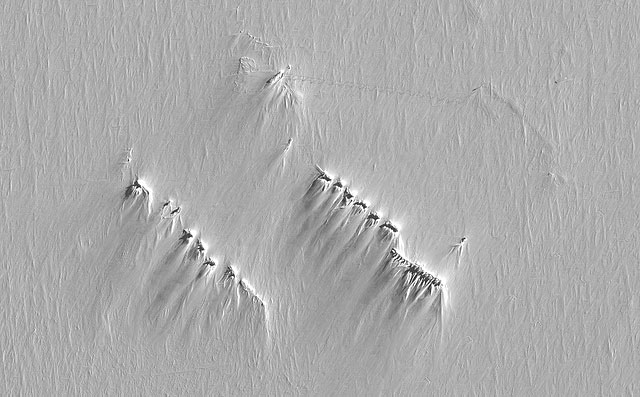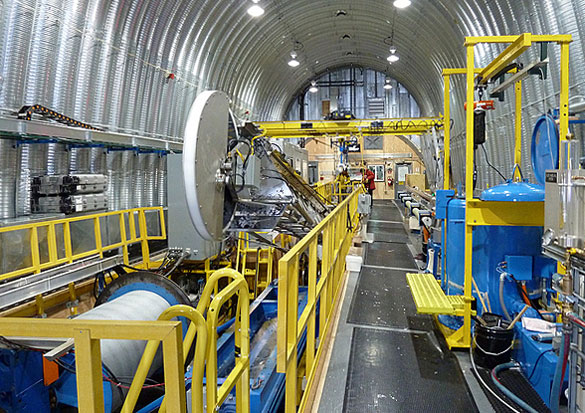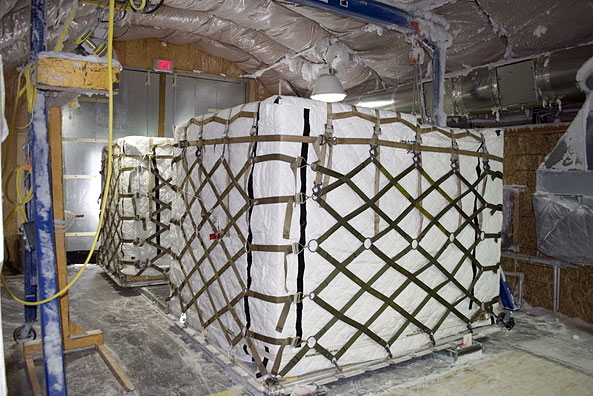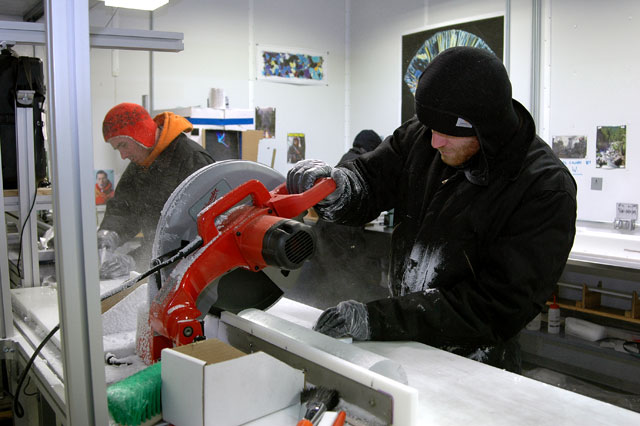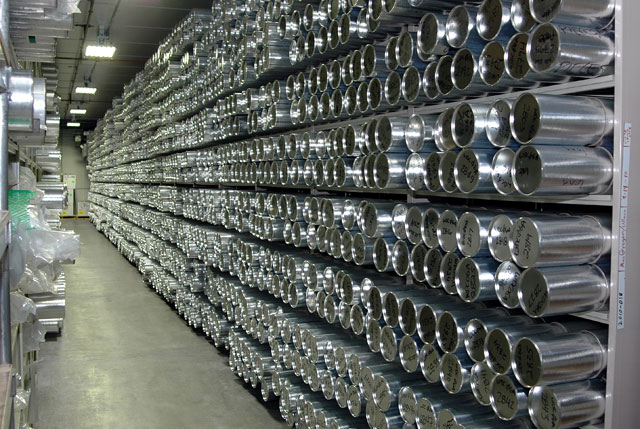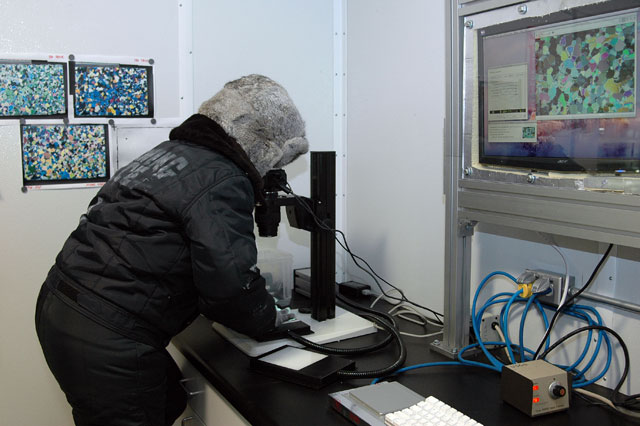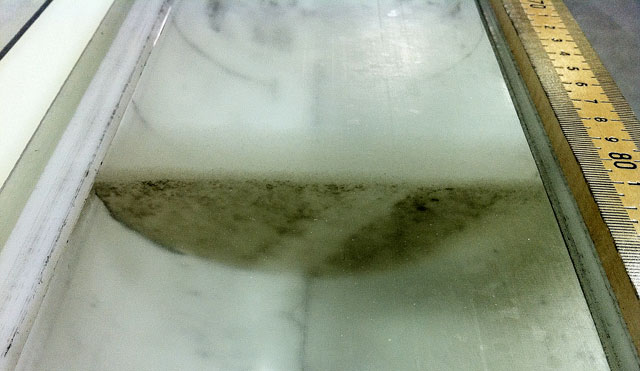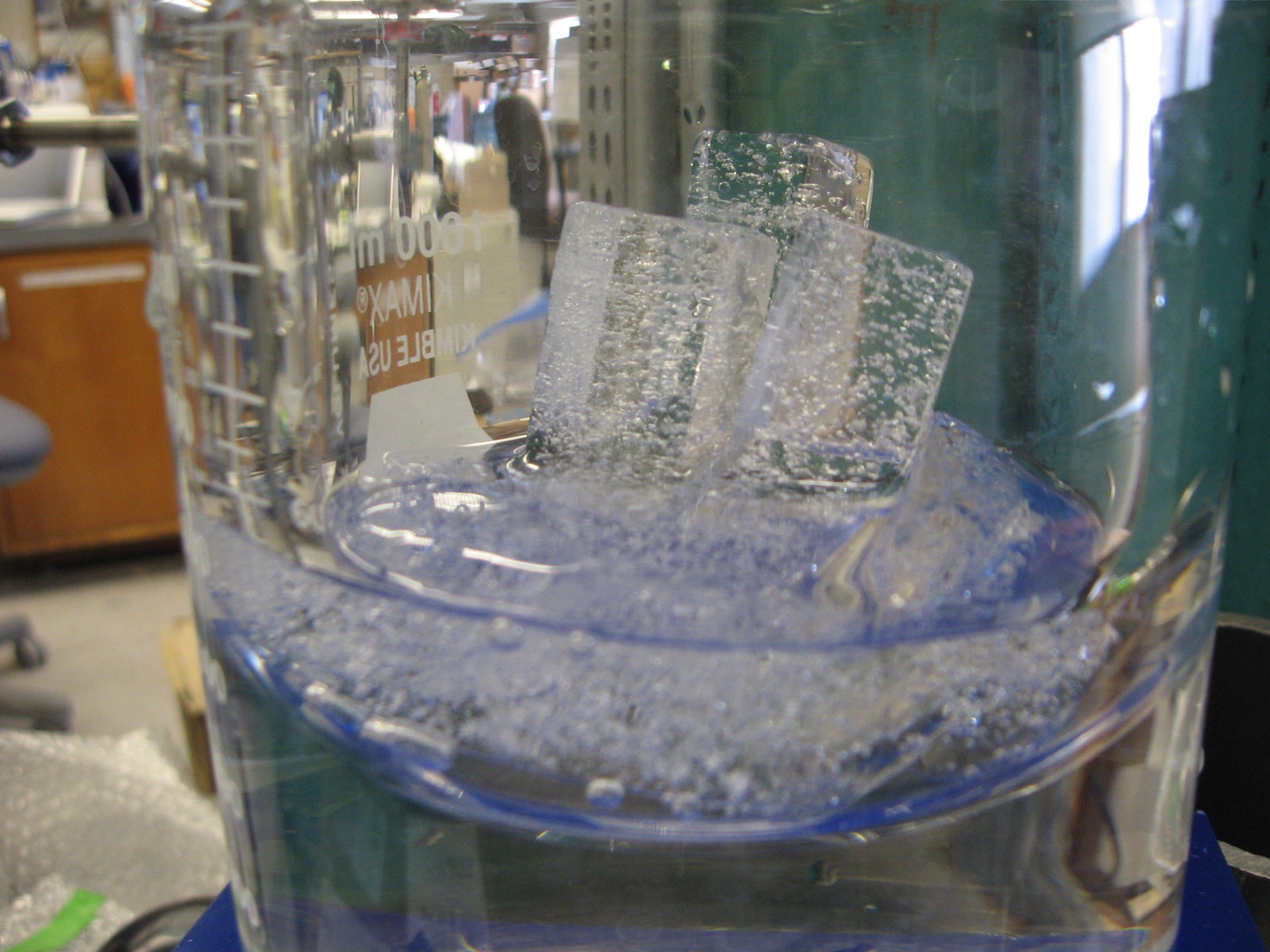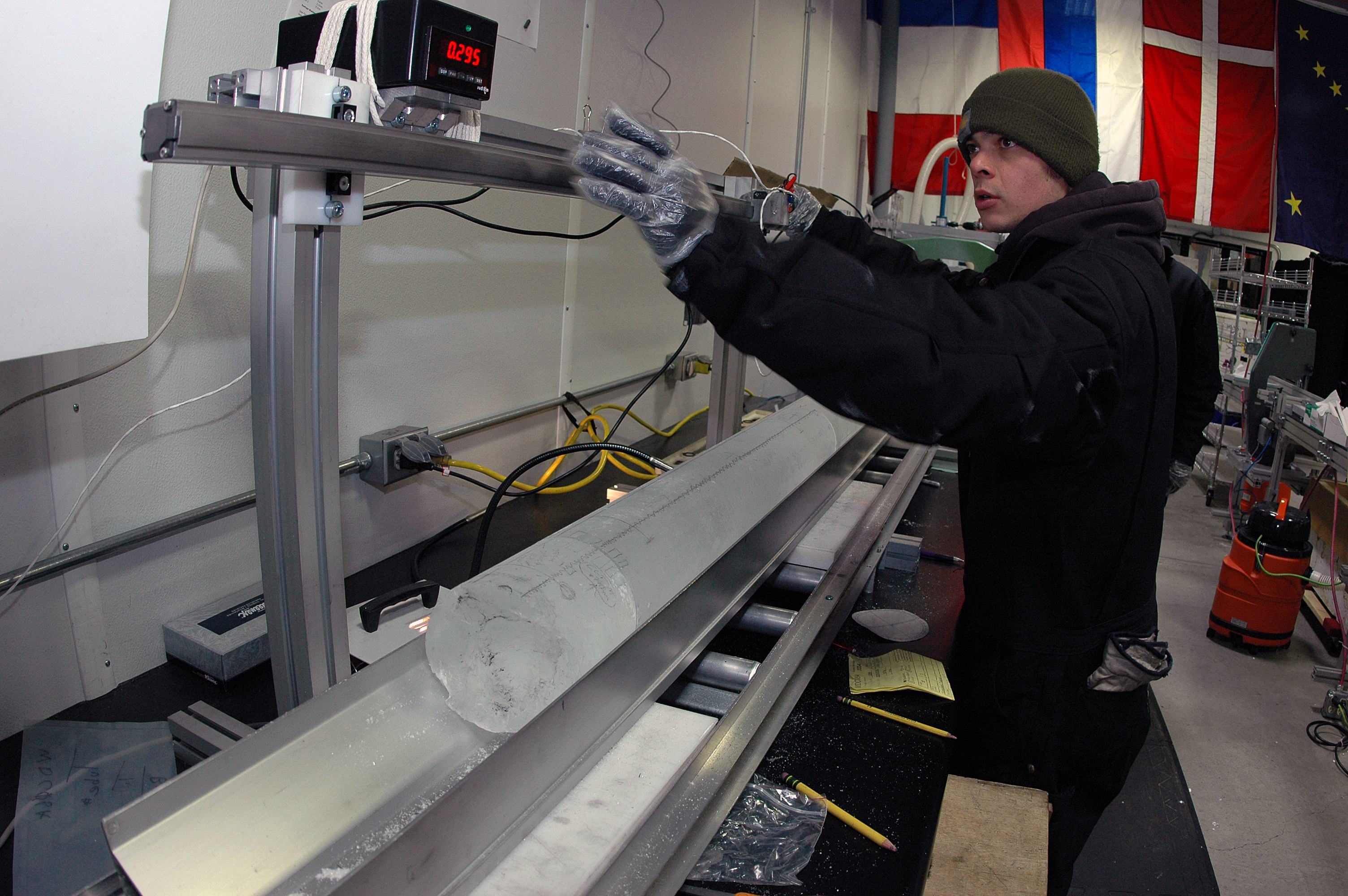
Mick Sternberg had literally made the same measurement a thousand times before. But this meter-long ice core was perhaps just a little more special. He double-checked his numbers on the final length, stood back, and rechecked again.
"No reason to rush through this," he said under his breath, which steamed out in the freezing temperatures of the National Ice Core Laboratory's processing room.
After all, this last section of ice, drilled from near the bottom of the West Antarctic Ice Sheet (WAIS) at a depth of about 3,331 meters, had been waiting around for a while. Probably somewhere in the neighborhood of 55,000 to 60,000 years.
Sternberg, an intern at the National Ice Core Lab (NICL), gave a nod and the cylinder of ice moved down the ice-core processing line shortly after 3 p.m. on Aug. 16. It would be trimmed, scanned, sliced and diced to be sent out with tons more ice to laboratories around the United States for various analyses.
"It's really cool to be here at the end of this," said Ed Brook, one of the principal investigators on the WAIS Divide project whose lab at Oregon State University is one of several analyzing the trapped gases in the ice core, particularly those associated with the greenhouse effect, like carbon dioxide and methane.
"I'm pretty confident that the data are going to be as good as we said they would be, just looking at the ice and its quality, and as good as the processing has been," he added.
The cores had been extracted from a high, snowy spot in West Antarctica where ice begins to flow in different directions, akin to the Continental Divide in the United States. The location would help guarantee a simple stratigraphy, with thick layers that represent individual snowfall years that went deep into the ice sheet. Researchers believed they would be able to construct a climate record from the ice so good that they could count the individual years for at least 40 millennia.
"The quality of the ice is better than we expected. The age of the ice is younger than we expected, but for most of what we're doing, that's a good thing, because it gives us a higher time resolution for our record," explained Kendrick Taylor, chief scientist of the WAIS Divide project, who was at NICL a few weeks earlier.
The project reached its target depth in West Antarctica on Jan. 28 after five years of drilling, representing the deepest core ever drilled by the U.S. ice-coring community. [See related article: Deep core complete.] Researchers had expected to recover ice as old as 100,000 years, but preliminary indications from the ice-core processing line (CPL) at NICL are that it is maybe 60,000 years old at the bottom.
"We're trading off the amount of time covered by the record for a record with more detail. To some extent, it's disappointing that we're not going to get the last interglacial period," Brook said, referring to a warmer time more than 100,000 years ago between ice ages, though it was unlikely the record would have gone back that far in time. The present time, called the Holocene, is also an interglacial period.
"Instead, we're going to get a lot more information about younger times. It's actually a good fit for what's needed to understand Antarctic climate. It's going to be a more unique record than if it was longer," he said.
Constraining CO2
Topping the science goals is the reconstruction of carbon dioxide concentrations in the atmosphere over the timeline represented by the WAIS Divide core at a resolution never before achieved.
CO2 is one of the primary greenhouse gases that most researchers believe is causing the planet to warm and the climate to change. They are particularly interested in determining whether natural increases and decreases in CO2 in the past preceded or followed temperature changes. That would help scientists better understand the relationship between temperature and CO2 today.
Other ice cores have shown that CO2 lags temperature, but there is uncertainty about the timing because the age of the ice is different from the age of the trapped gases, sometimes on the scale of centuries or millennia. The WAIS Divide core should be able to constrain much of that uncertainty because the annual layering offers such a highly detailed view of the past.
"I feel very confident saying this is really the best place on the planet to figure how greenhouse gases influence the climate on the timescale of the last 50,000 years or so," said Taylor, a research professor at the Desert Research Institute in Nevada.
Processing ice
But first, all of the ice has to pass through NICL, a facility managed by the U.S. Geological Survey and funded by the National Science Foundation (NSF), which also supported the WAIS Divide project.
NICL staff and scientists (many of them students) from the labs collaborating on the WAIS Divide project spent most of the summer processing more than 1,300 meters of ice. A team processed a similar amount of ice from WAIS Divide last year as well. [See related article: On the line.]
The Antarctic ice had been flown from the field camp in West Antarctica by military cargo plane to McMurdo Station, and then shipped to Port Hueneme, Calif. It was eventually trucked to Lakewood, Colo., where the NICL ice core warehouse and facility are located on the sprawling Denver Federal Center campus.
The CPL seems more like lumberyard than laboratory. Technicians and scientists operate various saws to carve out sections of ice for different sorts of analyses. For example, long sticks of ice will be melted for different chemical measurements covering 70 percent of the elements in the periodic table.
The chemistry can reveal information about past conditions such as sea ice extent, the amount of dust in the atmosphere and even seasonal changes, which reveals clues to the environmental conditions of the time.
Results are still months, if not years, away for some of the project's biggest science goals, according to Taylor.
"The ice that we're cutting today won't be sampled by labs for a year, two years. We have so much ice right now," said Taylor.
Drilling deeper
And there's still more ice to come.
Researchers plan to return to West Antarctica in 2011-12 to extract up to 100 more meters of cores. They will stop 50 meters away from the bottom of the ice where they expect there is a thin layer of meltwater on top of rock. The 50 meters of ice they leave behind will prevent contamination of the pristine water.
However, ice that deep starts to do strange things. In the last couple of hundred meters, the team started to detect irregular flow patterns in the ice, which make the record a bit fuzzy.
"At some point as you approach the bed, every ice core will start to show disruption in the stratigraphy. It can't be helped, because the drag is so significant at the bed, whether it's frozen to the bed or not," explained Joan Fitzpatrick, a scientist at the USGS who works on the physical properties of the core, down to individual ice grains.
A few weeks before the final core was processed, the CPL team noticed some irregular flow in sections of the core as it passed below 3,000 meters, including dramatic slopes in visible ash layers, likely from ancient volcanic eruptions.
To further investigate the severity of the irregularities, Fitzpatrick cut thin sections of the core to analyze the individual grains to see if their orientations have changed. The illumination system she uses makes the thin sections look like colorful kaleidoscope images.
If the grains are in a different orientation, Fitzpatrick said, then "you know you have some significant stratigraphic disruption going on and all bets are off."
However, more recent discussions among the team following the CPL and after examining the evidence has encouraged the researchers that going deeper would be worthwhile.
Replicating data
A new type of instrument called a replicate coring drill is being created by the engineers at the Ice Drilling Design and Operations (IDDO) group at the University of Wisconsin-Madison. The smaller drill will fit into the original borehole and core into the side, retrieving additional ice for analysis from layers of particular interest.
Researchers are especially keen to examine abrupt climate changes in the past, especially the transition from the last ice age to the current warm period. The gas measurements by Brook and others often require large volumes of ice, so additional samples at different depths will be very useful.
"We are collecting quite a bit more gas samples than previous ice core projects, and the reason for that is that we've learned there's a lot of information to be obtained from gases at this high resolution," Brook said.
The gas record is so important, particularly the CO2 data, that the team cutting ice for those measurements purposefully avoids sections of the core that show high dust concentrations. Dust in the core can interact with acids in the ice and release CO2 in situ, skewing the data. That's why cores from Greenland, which is surrounded by land in the Northern Hemisphere, aren't as a reliable source for past carbon dioxide concentrations in the atmosphere.
That's another reason for the high hopes surrounding the WAIS Divide ice core.
"We are going to get a record of greenhouse gases that extends back 40,000 years, with the highest possible time resolution. The record will be used to test and improve the computer models that are used to determine the extent that human activity is influencing climate. It is great to be part of this team," Taylor said.

